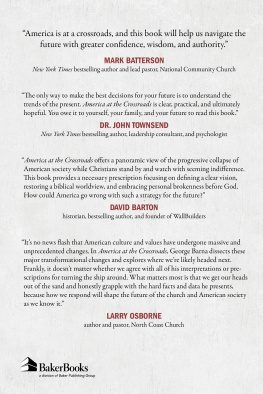T HE P OWER OF T EAM L EADERSHIP
P UBLISHED BY W ATER B ROOK P RESS
12265 Oracle Boulevard, Suite 200
Colorado Springs, Colorado 80921
A division of Random House, Inc.
All Scripture quotations, unless otherwise indicated, are taken from the Holy Bible, New International Version. NIV. Copyright 1973, 1978, 1984 by International Bible Society. Used by permission of Zondervan Publishing House. All rights reserved. Scripture quotations marked ( KJV ) are taken from the King James Version. Scripture quotations marked ( TLB ) are taken from The Living Bible copyright 1971. Used by permission of Tyndale House Publishers, Inc., Wheaton, Illinois 60189. All rights reserved.
Copyright 2001 by George Barna
Published in association with Sealy M. Yates, Literary Agent, Orange, California.
All rights reserved. No part of this book may be reproduced or transmitted in any form or by any means, electronic or mechanical, including photocopying and recording, or by any information storage and retrieval system, without permission in writing from the publisher.
W ATER B ROOK and its deer design logo are registered trademarks of WaterBrook Press, a division of Random House, Inc.
Library of Congress Cataloging-in-Publication Data
Barna, George.
The power of team leadership : achieving success through shared responsibility / by George Barna.
p. cm. (Barna reports for highly effective churches series)
Includes bibliographical references.
eISBN: 978-0-307-83123-1
1. Group ministry. I. Title.
BV675 .B37 2001
253dc21
2001039002
Previously released in a slightly different version by Issachar Resources under the title Building Effective Lay Leadership Teams.
v3.1
CONTENTS
CHAPTER ONE
Are We Setting Up Pastorsand Churchesfor Failure?
The problem is not our leaders but the unhealthy expectations we have of them.
CHAPTER TWO
Why Team Leadership?
Are your church members merely consuming ministry, or are they doing ministry?
CHAPTER THREE
Without Vision, There Is No Leadership
God has a unique vision for your church and a significant vision for each ministry within your church.
CHAPTER FOUR
Why Teams Are Scarce (and Why They Shouldnt Be)
Few ministry philosophies I have studied come as highly recommended as that of lay-leadership teams.
CHAPTER FIVE
The People Factor in Team Development
Look for people who have the calling, the character, and the competencies to lead effectively.
CHAPTER SIX
The Four Leadership Aptitudes
Dont look for team leaders of similar aptitudes; look for those with complementary aptitudes.
CHAPTER SEVEN
Best Practices of Successful Team Leadership
Great outcomes do not happen by chance.
CHAPTER EIGHT
The Captain: The Teams Point Person
The selection of the captain can make or break the team.
CHAPTER NINE
Transitioning to a Team-Led Ministry
If the process is properly carried out, the results will justify the effort.
CHAPTER TEN
Land Mines in Team Territory
Be forewarned and prepare an intelligent response to these possible dangers.
CHAPTER ELEVEN
A Self-Examination
Solo leadership or team leadership: Which option is best for you?
C HAPTER O NE
ARE WE SETTING UP PASTORSAND CHURCHESFOR FAILURE?
 The problem is not our leaders but the unhealthy expectations we have of them.
The problem is not our leaders but the unhealthy expectations we have of them.Most of us have bought into an unhealthy understanding of leadership.
We have been taught that leadership is about one individuals performing all of an organizations critical tasksmotivating, mobilizing, directing, and resourcing people to fulfill a visionat a level of excellence and influence that separates him or her from the bulk of humanity. The combination of skills and abilities required to be a great leader has caused many people to lament the absence of leaders in our society.
Let me share why I believe we have unrealistic expectations for our leaders. In a nationwide survey we conducted among 1,005 adults, people identified those things they feel are very important for a leader to do. Here is the profile:
87 percent expect leaders to motivate people to get involved in meaningful causes and activity
78 percent believe leaders should negotiate compromises and resolve conflicts when they arise
77 percent look to leaders to determine and convey the course of action that people should take in order to produce desirable conditions and outcomes
76 percent rely on leaders to identify and implement courses of action that are in the best interests of society, even if some of those choices are unpopular
75 percent expect leaders to invest their time and energy in training more leaders who will help bring the vision to reality
63 percent want leaders to communicate vision so that they know where things are headed and what it will take to get there
61 percent say leaders are responsible for the direction and production of employees associated with the leaders organization or cause
61 percent think leaders should analyze situations and create the strategies and plans that direct the resources of those who follow them
56 percent hold leaders responsible for managing the day-to-day details of the operation.
The list goes on, but it clearly shows that we have developed an unreasonable notion of what a leader should do. Look at the breadth of tasks and abilities demanded by the expectations reflected in that surveyand realize, of course, that most people hold additional expectations beyond those listed. We expect the central leader not only to provide the corporate vision, but also to:
direct activity
encourage participants
supply resources
evaluate plans and progress
motivate participants
negotiate agreements
strategize
manage people
reinforce commitments
recruit necessary colleagues
communicate conditions, plans, and assignments
train new leaders
resolve conflicts
and so on
Who could possibly meet such a wide range of disparate expectations?
S ET U P FOR F AILURE
Would you agree that a person would have to be superhuman to accomplish all of these tasks? Yet thats what we expect a leader to do. No wonder we are consistently disappointed by leaders who seemed to hold such promise before they assumed positions of significant authority and responsibility. Our surveys have shown that during the past two decades there has been a continual decline in satisfaction with leadership in churches, government, nonprofit organizations, schools, businesses, and families.


















